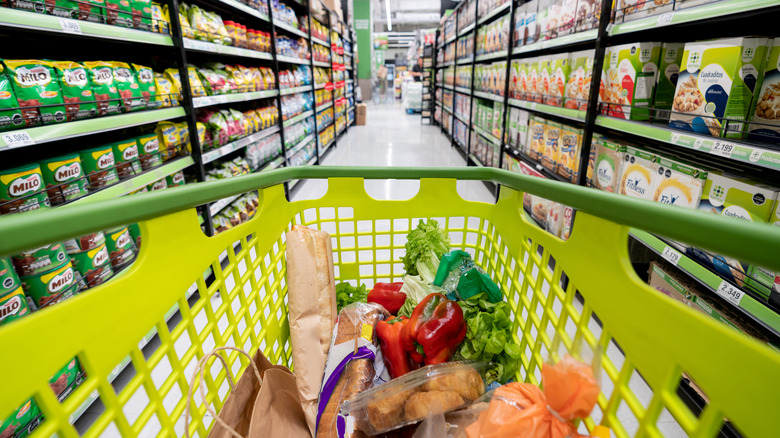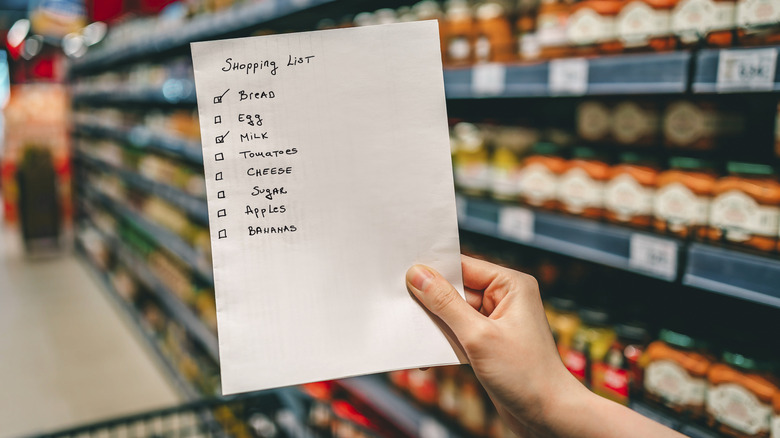The 6-To-1 Rule To Save Money (And Time) At The Grocery Store
Some people consider grocery shopping a chore, while others find it to be more of an adventure — what exciting finds will we score this week, and what are we going to do with them? Still, one thing nearly every shopper has in common these days is sticker shock, since yes, food prices continue to rise. Eating out is even more expensive, though, so we'll just have to suck it up and shop smarter.
Back in the late aughties, whenever anyone raised an issue, the automatic answer was "There's an app for that," but these days, it's more likely to be a TikTok video. In this case, the TikTok video du jour meant to solve everyone's grocery store woes revolves around the 6-to-1 shopping rule created by food content creator Will Coleman.
@chefwillco My 6 to 1 grocery method makes shopping cheaper and easier! Let me know how you like this grocery shopping method. #6to1method
The rule is actually a shortcut shopping list that lets you skip the specifics but instead focus on purchasing six different vegetables, five fruits, four sources of protein (meat, tofu, eggs, etc.), three starches (things like rice, noodles, or bread), two sauces or spreads, plus one "fun thing." According to Coleman, these purchases should take you through an entire week of meal planning, unless you have a large family. He feels the 6-to-1 rule will also save you time and money since you won't be buying anything unnecessary that would wind up going to waste.
The rule might not work for everyone
While Will Coleman insists that the 6-to-1 rule has worked for "me, my homies, and everybody on social media that has tried it," your mileage may vary. One person commenting on the TikTok video points out that the rule seems tailored to solo shoppers and might be more difficult for a family to implement, while others admit they really don't eat that many fruits and vegetables. If this is you, too, being a 6-to-1-er could mean you'd be shelling out big bucks for stuff that just rots in your produce bin. (Even if you buy canned or frozen produce, pantries and freezers can only hold so much.) You might also need fewer proteins, too — for example, one rotisserie chicken might be stretched out to make three days' worth of frugal meals.
Yet another way the 6-to-1 method may let you down is by not allowing you to take advantage of all the deals your supermarket offers. Perhaps the meat department has 50% off on steaks, or there's a BOGO on butter. In that instance, why pass up the chance to stock up and fill your freezer? (Yes, butter freezes quite nicely.) Also, where do staples like salt and flour fit in? Nor do beverages appear to be covered, unless you own a juicer or stick with tap water. Finally, that "one fun item" doesn't mean you have license to bust your budget on caviar or foie gras (unless they, too, are deeply discounted).
Here are some other ways to save on groceries
Whether or not you choose to shop using the 6-to-1 method, there are some other rules you can follow that will help you maximize your savings at the supermarket. The number one rule may also be the most boring: Make a list before you start shopping. Paper and pencil too 20th century for you? That's okay; there's an app for that. Quite a few of them, actually, from simple note-taking apps to ones that allow you to sort purchases by store section and sync your list with ones made by other household members.
You should also sign up for your preferred stores' loyalty programs whenever possible — yes, they are tracking your purchases, and what of it? It's not terrible to have the store send you coupons tailored to your specific purchasing patterns, and the savings can be significant. If you download the store's app, you might also be able to clip e-coupons strictly on an as-needed basis. If you're interested in an item and the label notes that you get 50 cents off with a coupon, open the app and download it on the spot instead of wasting time collecting coupons for items you're unlikely to use.
Don't be afraid to shop for clearance items, either. Many of these may be marked down simply because the store needs to make room for new stock, but even stuff nearing its sell-by date can be stored in the freezer for later use.


